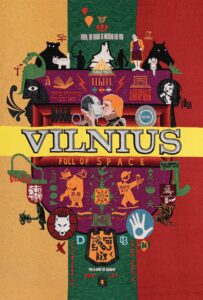Vilnius. Heraldry of the 21st Century
6 June – 8 September 2023
 Vilnius. Heraldry of the 21st Century is a project by Studio 75B (Rotterdam, the Netherlands) that has been continuing since 2001. Its creators aim to present cultural content to the general public through visual communication. The purpose of this project is to research, analyse and create the heraldry of contemporary urban societies in the form of heraldic tapestry. This is how the heraldic tapestries of Rotterdam, Amsterdam, Los Angeles, Hamburg, Milan and other cities were born, now joined by a piece dedicated to Vilnius. This heraldic tapestry is comprised of slogans, symbols, logos and signs that Studio 75B considers important to, and characteristic of, Vilnius today. Using the classical form of the coat of arms and the traditional Dutch tapestry weaving technique (the tapestry was woven at Textiellab Tilburg – the Textile Museum in Tilburg), it is an example of contemporary heraldry communicated in a recognisable manner, created by combining fragments of city imagery that carry a certain meaning.
Vilnius. Heraldry of the 21st Century is a project by Studio 75B (Rotterdam, the Netherlands) that has been continuing since 2001. Its creators aim to present cultural content to the general public through visual communication. The purpose of this project is to research, analyse and create the heraldry of contemporary urban societies in the form of heraldic tapestry. This is how the heraldic tapestries of Rotterdam, Amsterdam, Los Angeles, Hamburg, Milan and other cities were born, now joined by a piece dedicated to Vilnius. This heraldic tapestry is comprised of slogans, symbols, logos and signs that Studio 75B considers important to, and characteristic of, Vilnius today. Using the classical form of the coat of arms and the traditional Dutch tapestry weaving technique (the tapestry was woven at Textiellab Tilburg – the Textile Museum in Tilburg), it is an example of contemporary heraldry communicated in a recognisable manner, created by combining fragments of city imagery that carry a certain meaning.
Cities are seemingly becoming more and more alike. This is due to the ubiquity of international brands, which can obscure and even completely eliminate the local, site-specific iconosphere. In most cities, you will find recognisable hotel, restaurant or supermarket chain branding. These familiar logos catch the eye of the newcomer, creating the impression that cities are becoming more unified with less and less unique identity. However, despite all this, cities still have specific signage and other visual phenomena with which the local residents identify. Such landmarks reflect both the older and the more recent history of each city. The tapestry’s creators, designers Rens Rogier Muis and Pieter Cornel Vos, have included in their work everything that they see as constituting today’s Vilnius. This includes the city’s most important institutions, the buildings that shape the capital’s urban image, the sculptures that every Vilnius resident recognises, and the logos that can be seen on its newsstands or the facades of shopping centres. But the tapestry eschews any hierarchy: in it, you will find everything from street art and graffiti to cult novels about Vilnius, from monuments to bars, from clubs to cafes. Here, Vilnius is shown as an accumulation of unique signs as seen through the eyes of Dutch designers, based on extensive iconographic research and interviews with Vilnius residents, analysed and transformed into a lightly ironic work of art. The creators see it not as a commercial project in city marketing but as an outcome of a subjective analysis. They never take on commercial commissions or institutional assignments, preferring instead to have the freedom to personally and independently choose the content and form of their work.
The 700th anniversary of Vilnius is a great opportunity to capture the ever-changing landscape of signs and symbols in contemporary Vilnius. The heraldic tapestry of Vilnius embodies and signifies what the artists consider to be the visual uniqueness of Vilnius. However, each of the signs that make up the tapestry is also a story about some aspect of the capital’s culture, literature, architecture, street art and life itself, and the recent history of Vilnius. Ironic, colourful, egalitarian, just as Vilnius is today.
Curator of the exhibition Evaldas Stankevičius
3A Arsenalo st, Vilnius, Lithuania
+370 5 212 1813;
+370 5 261 25 48; +370 5 262 80 80.
tddm@lndm.lt













